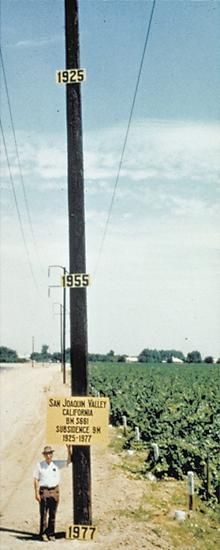
© USGSA pole is marked with the land levels in Mendota, California, showing the drastic sinking of the land for nearly a century.
Walk into any grocery store in America and there's a good chance the fresh produce you see there was grown in California.
Up to half of the nation's fruit, nuts and vegetables are grown in the Central Valley, one of the planet's most fertile growing regions, between Los Angeles and Sacramento.
Now, for the first time this century, the entire state is in severe to exceptional drought.
"It's really depressing for us to leave ground out. We're still paying taxes and payments on everything that's non-production," said Gene Errotabere, whose family has farmed the valley since the late 1920s. "I mean, it's this whole valley. It's just a breadbasket of our whole country here, and to see this much ground being fallowed is not something I like to see."
Comment: What if it's not drought per se that is causing California to sink, but 'Earth opening up' from below that is causing aquifers to disappear?
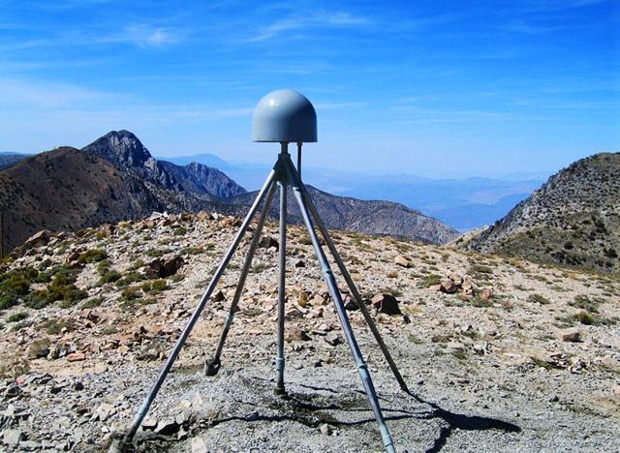
© Shawn Lawrence, UNAVCOPlate Boundary Observatory GPS station P466, located in the Inyo Mountains near Lone Pine, California. P466 is mounted on a deep-drilled braced monument, and its displacement data were used in the determination of water loading changes in the western U.S.
About 63 trillion gallons of water have been lost to drought in the western United States, enough to blanket the region with 4 inches of water, according to a study published Thursday.
Researchers at the Scripps Institution of Oceanography at the University of California, San Diego, arrived at the conclusion by measuring the level of the earth's crust with a network of GPS stations that is normally used to predict earthquakes.
When water is lost because of a lack of rain and snow, the earth's crust rises. The sensors show that the earth's crust has risen an average of
4 millimeters in the western United States since last year and as much as 15 millimeters in the California mountains.
The earth's crust typically sags in the winter and spring, weighed down by water, and it rises during the dry season in summer and fall, said co-author Adrian Borsa. The authors removed those seasonal factors when analyzing about a decade of data from GPS stations within the National Science Foundation's Plate Boundary Observatory.
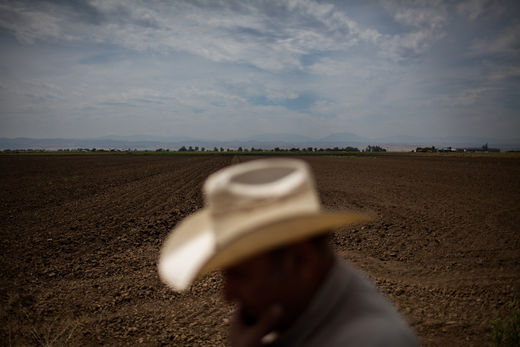
© Max Whittaker/Prime/Washington Post
When the winter rains failed to arrive in this Sacramento Valley town for the third straight year, farmers tightened their belts and looked to the reservoirs in the nearby hills to keep them in water through the growing season.
When those faltered, some switched on their well pumps, drawing up thousands of gallons from underground aquifers to prevent their walnut trees and alfalfa crops from drying up. Until the wells, too, began to fail.
Now, across California's vital agricultural belt, nervousness over the
state's epic drought has given way to alarm. Streams and lakes have long since shriveled up in many parts of the state, and now the aquifers - always a backup source during the region's periodic droughts - are being pumped away at rates that scientists say are both
historic and unsustainable.
One state-owned well near Sacramento registered an astonishing 100-foot drop in three months as the water table, strained by new demand from farmers, homeowners and municipalities, sank to a record low. Other wells have simply dried up, in such numbers that local drilling companies are reporting backlogs of six to eight months to dig a new one.
Lizard diet ridiculed but Central America's poorest country is facing hunger because of poor harvests and rising food prices
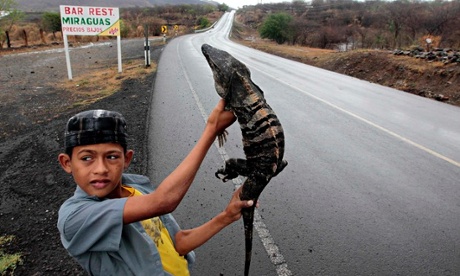
© Oswaldo Rivas/ReutersA boy holds up an iguana for sale on the highway in the north of Managua. Nicaraguans are being encouraged to eat the reptiles as a nutritious alternative to more conventional meat.
Nicaraguans struggling to afford meat as the country suffers its worst drought in 32 years should
consider raising and eating iguanas, a government expert has suggested.
The advice comes amid warnings that
Nicaragua, Guatemala, Honduras and El Salvador could require levels of humanitarian aid not seen since the aftermath of
hurricane Mitch 16 years ago, as
poor harvests and rapid increases in the prices of staple items threaten a food crisis."Breeding iguanas brings two benefits," said Guillermo Membreño, a land management expert. "Not only does it supply dietary protein, it also offers a commercial use for the animals."
Iguanas, he added, contained 24% protein compared with 18% in chicken.Although Nicaragua's environmental laws forbid the hunting of iguanas between 1 January and 30 April each year, the lizards can be kept for food and even exported under certain circumstances.
"Farming iguanas - and not hunting them in forests - is a good way to deal with the food shortages caused by the prolonged drought," Membreño told the government-run online newspaper
La Voz del Sandinismo.
"Even if you've only got 10 iguanas, you've got something that offers food - and cash if you sell the iguanas for their meat, their skins or as pets." He also suggested people grow moringa trees, which require little water and the leaves of which can be used as a highly nutritious animal feed.
Comment: FEWS NET is a door-opener for USAID, which is a front for the CIA.
As for the delicacy of iguana...we all may have to consider alternate food supplies for nutritional value, given the drought in C.A. is not unique. Other areas of the world are experiencing the same or other conditions in escalating intensity. Food shortages and skyrocketing prices are on the near horizon in global proportions. Think and plan ahead...
Anastasia Moloney
ReutersThu, 14 Aug 2014 01:39 UTC
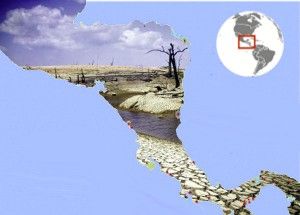
© www.bluechannel24.comExtreme and persistent drought conditions affect most of Central America.
An unusually hot season and extended dry spells have brought drought to areas in eastern and western Guatemala and El Salvador, southern Honduras and northern and central Nicaragua, destroying swathes of bean and maize crops, the region's staple foods, and putting pressure on subsistence farmers and food prices.
"Extremely poor households across large areas of Guatemala, Nicaragua, Honduras, and El Salvador will experience a rapid deterioration in their food security in early 2015.
"Atypically high levels of humanitarian assistance, possibly the highest since Hurricane Mitch in 1998, will likely be required in order to avoid a food crisis," said a recent report by the Famine Early Warning Systems Network (FEWS NET), run by the US Agency for International Development (USAID).
Comment: The problem with FEWS NET working in conjunction with and funded by USAID smacks of it being an information source and subsidiary front for the CIA. How better to gain the confidence of starving people and troubled farmers/ranchers than to send tentacles into their communities through humanitarian aid organizations and research groups engaging local talent and resources for strategic fixes.
USAID (CIA) has had known undercover activities directly, through NGOs, contracted companies or various agencies in: Ukraine, Syria, Libya, Egypt, Iran, Cuba, Haiti, Indonesia, Pakistan, Bolivia, Nicaragua, Peru, Palestine, Philippines, Laos, South Vietnam, Thailand, Palau, Malaysia, Uruguay, Albania, Kazakhstan, Senegal, Nigeria, Gabon, Gambia, Madagascar, Uganda, Tanzania, Java, Sumatra, Honduras, Nepal, Costa Rica, Georgia, Kyrgyzstan, Caucasus, Eritrea, Tanzania, Zaire, South Africa...to name a few.
USAID (CIA) under-cover activities include: fomenting rebellions, NSA info gathering, political coups, installing dictatorships, reengineering economies, cronyism, destabilizing banking systems, undermining governments and elected politicians, spying, bribery, training special forces in torture tactics, weapons purchase and distribution, election interference, absconding and re-appropriating funds, funding or training guerrilla armies and movements, propaganda broadcasts, destabilizing regimes, distributing narcotics as rewards, links to terrorist organizations, assisting border wars, "accidental" assassinations, funding figureheads, breaking U.S. laws, money funneling to contras, co-opting national movements, exploitation of local resources, instability assessments, fraud and smuggling.
What are the chances FEWS NET is what it says it is?
Brazil's biggest city is running out of water and options. The worst drought to hit the Sao Paulo region in 84 years is forcing local authorities for the second time in a year to put water pumps below the gates of the main reservoir, where the level has dropped sharply, so water can flow to the city's 9 million people.
Federal prosecutors are also demanding that state officials immediately present a plan for water rationing, warning that otherwise the reservoir could go dry. At Jaguari dam, one of the basins of the Cantareira System, cracks are spreading in the mud, scaring longtime residents who say they haven't experienced a water shortage like this in a long time.
"I had never seen the reservoir like this, nor anyone else living here," said Nestor Algario, who lives in Braganca Paulista, north of Sao Paulo.
The region got only a third of the usual rain during Brazil's wet season from December to February. Experts complain about the government's response, saying officials have been more focused on the city's hosting of several World Cup games, and the campaigning by candidates for presidential and gubernatorial elections.
Andrea Thompson, Climate Central
The Raw StoryTue, 12 Aug 2014 14:17 UTC
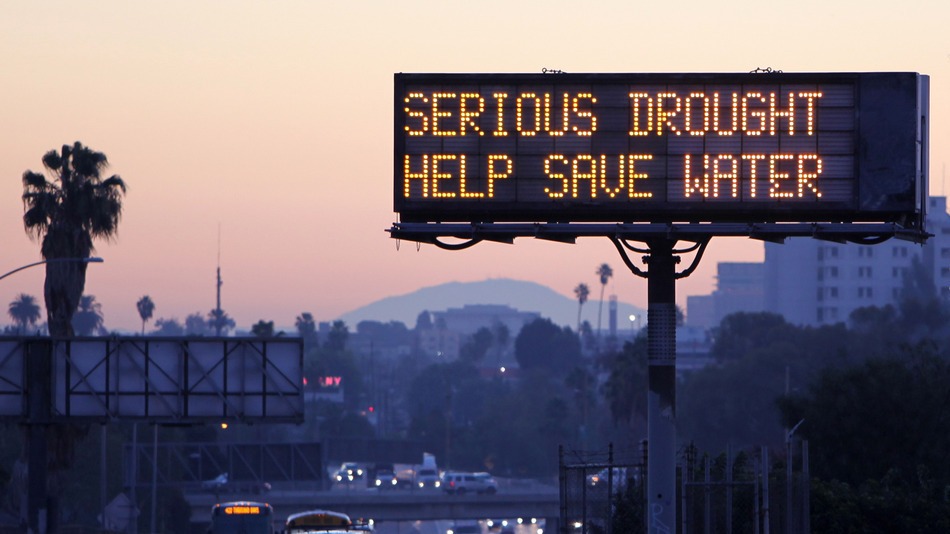
© mashable.comFreeway sign in Los Angeles. No end in sight for California drought.
On Tuesday, the
National Climatic Data Center (NCDC) released its monthly climate update for the U.S. and it contained more cruel news for California. Precipitation was near average throughout the state, but it had a negligible impact on the state's
record-setting drought because summer is its dry season. To reinforce that, NCDC noted that
while San Francisco received 800 percent of its usual July rainfall, that equalled only 0.08 inches.
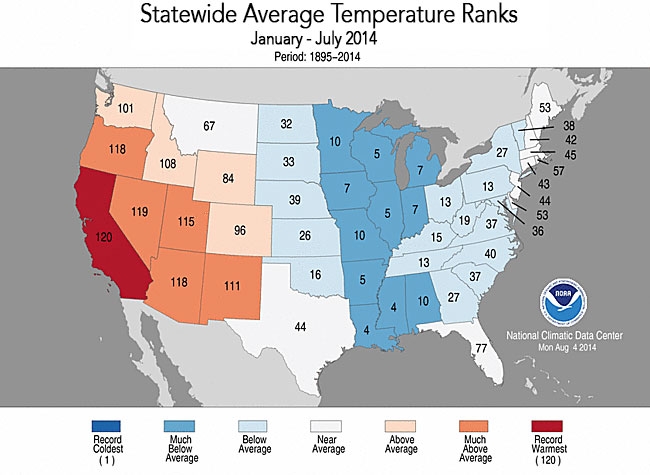
© NCDC
Heat continued to bake the state, fueling a drought that's projected to
cost $2 billion by year's end. California had its fifth-warmest July on record, including pockets of record warmth along the northern coast.
July's heat kept the state on track for its warmest year in 120 years of recordkeeping. Since January, the state's average temperature has been 4.6°F above the 20th-century average. That smashes the previous record by 1.4°F.
Five other western states had their top 10 warmest Julys as well, which helped to fuel large wildfires. In Washington, which had its fifth-warmest July, the
Carlton Complex Fire burned more than 250,000 acres. In Oregon, which had its second-warmest July, the
Buzzard Complex Fire charred more than 400,000 acres. Despite those two large fires, the amount of acres burned by wildfires nationwide is at a 10-year low.
While heat was the story in the West, persistent cool weather continues to be the story for the eastern half of the country.
The Midwest and Southeast were in the bullseye for a mid-summer's chill with 12 states stretching from Louisiana to Michigan recording one of their 10-coldest Julys. That includes a record cool July for Indiana and Arkansas.
Comment: Climate Central claims it is "a leading authority on climate science that cuts through the hype with a clear-eyed analysis of climate change, delivering just the facts and findings." Its world weather attribution project looks at the role of global warming in extreme weather events and identifies a human fingerprint. This initiative performs extreme "weather autopsies" immediately after an extreme weather event and makes a snap determination for the waiting media. They state four possible outcomes of the attribution analysis: #1) global warming increased the likelihood of the event, #2) global warming did not play a role in the event, #3) global warming reduced the likelihood of the event, and #4) the model was unable to reproduce the event. In example, Climate Central has deemed "manmade climate change significantly increased the odds of the killer European heat wave of 2003 and the Russian heat wave of 2010. Their bottom line is "YES, these events fit a pattern that climate scientists have long expected to appear as the result of increased greenhouse gasses in our atmosphere." A general scientific agreement is that global warming has contributed a trend toward more intense extremes of heat and precipitation around the world, is partly to blame for specific extreme weather events and will continue to influence both in the future."
Sounds like this ultra-scientific, fact-finding, data-digging, leading authority is feeding a pre-determined agenda with pre-determined results. It is doubtful outcomes #2,#3,#4 are ever factors. Those options do not make headlines. Greenhouse gas does.
RTFri, 01 Aug 2014 04:08 UTC
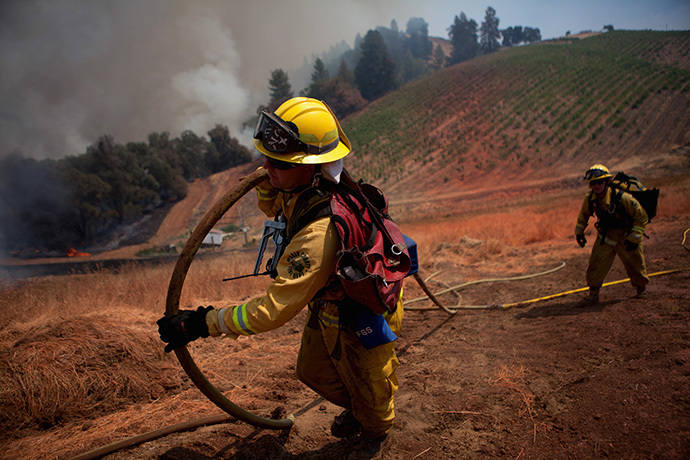
© Reuters/Max WhittakerMarin County firefighters haul a hose on a fire line while battling the fast-moving wildfire called "Sand Fire," near Plymouth, California July 26, 2014.
The drought in California is getting worse as more than half the state now suffers from the most severe drought conditions possible, according to a new report.
The recent study
published by the US Drought Monitor noted that 58 percent of California is experiencing "exceptional drought," which is the most serious category on the agency's five-level scale.
It's also the highest percentage to be recorded since the federal government started monitoring drought levels in the 1990s.
What's more alarming, however, is the fact that before 2014, no parts of California ever suffered from such severe conditions. As the
Los Angeles Times notes, the rate at which this level of drought has spread throughout the state is unprecedented. In fact, about 22 percent of the state was moved into the "exceptional" category during the last week.
"You keep beating the record, which are still all from this year," National Drought Mitigation Center climatologist Mark Svoboda told the
Times.
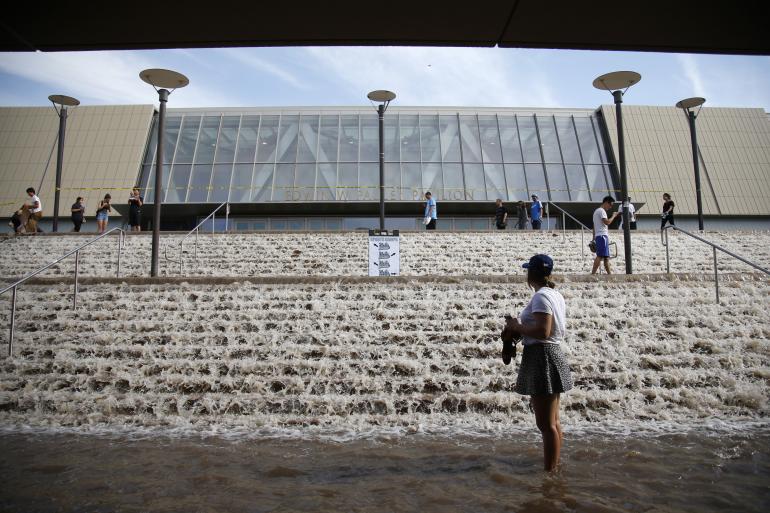
© Reuters/Danny MoloshokA woman looks up from an underground parking structure outside UCLA's Pauley Pavilion sporting arena as water flows down the stairs from a broken thirty inch water main that was gushing water onto Sunset Boulevard near the UCLA campus in the Westwood section of Los Angeles July 29, 2014
An official at the city's Department of Water and Power, or DWP, was questioned about the delay in stopping the flow of water after an estimated eight to 10 million gallons of water poured out from a
ruptured 93-year-old water pipe, according to the
Los Angeles Times."We had to do research to get to the correct valve," Jim McDaniel, a DWP senior assistant general manager, said, according to the
LA Times, adding that the closure of a wrong valve could have left many people without water. The water had been reportedly flowing for more than three hours before the flow was cut off.
Los Angeles Councilman Paul Koretz reportedly said: "
Unfortunately, we lost a lot of water, around 35,000 gallons a minute, which is not ideal in the worst drought in the city's history."
Ian Schwartz
CBS13Fri, 25 Jul 2014 10:55 UTC
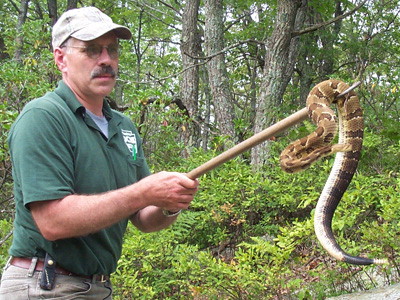
© www.dcnr.state.pa.usRattlesnake removal from their temporary residences near homes and parks.
Len Ramirez says his rattlesnake removal
business says this is one of the busiest year's he's seen in nearly 30 years.
And it's only halfway done. "We've made four calls today, and tonight I don't know how many I'm going to make this evening, but it's going to be a long evening," he said.A room where he keeps rattlesnakes he catches before releasing them into the wild is evidence of how busy he's been.
"We've removed 72 rattlesnakes this week," he said.Drought conditions have kept the calls coming in from people spooked by a snake that's way too close for comfort.
"For a lot of homeowners just moving in from the Bay Area, first-time encounter with a rattlesnake is very scary," he said.More snakes are coming closer to homes, something he says is likely because of the drought. People aren't watering as much, so there isn't water all over the ground away from homes. That leads rodents that are a food source for the snakes closer to homes in search of water.He says pets could be most at risk if they accidentally sniff a spot a rattlesnake calls home. He also recommends keeping garage doors closed.
Comment: Snake bites can cause severe swelling, bruising pain at the bite site, internal bleeding and sometimes breathing problems. If treated with antivenom at a hospital, they are rarely fatal. Since snake bite kits have recently been considered an outmoded and dangerous idea and the Sawyer Extractor is not very effective, the best recommendation is to dial 911 and get to a hospital ASAP. Immobilize the bitten limb and keep it below the level of the heart...but get help pronto.




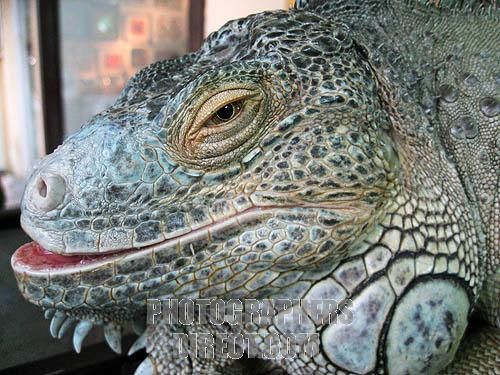

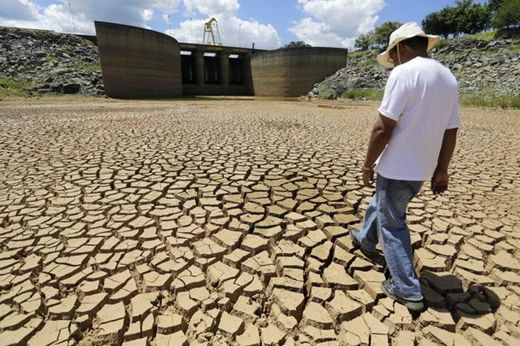








Comment: What if it's not drought per se that is causing California to sink, but 'Earth opening up' from below that is causing aquifers to disappear?